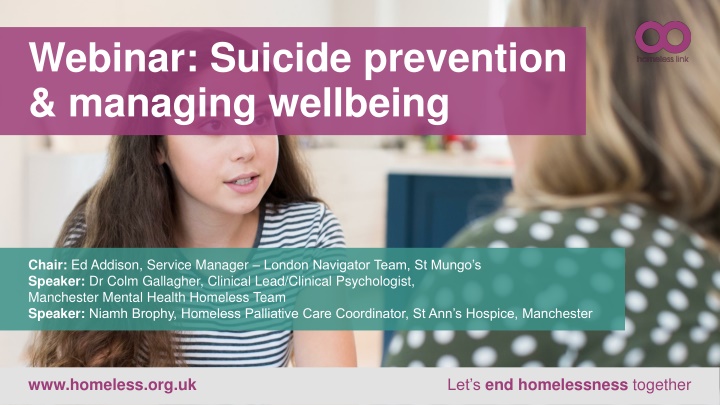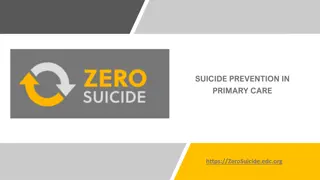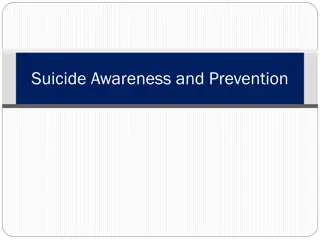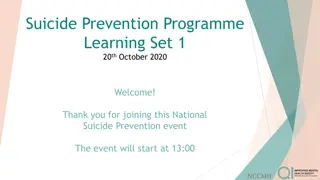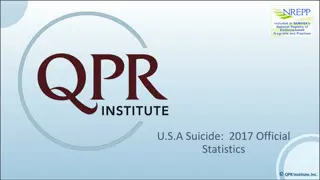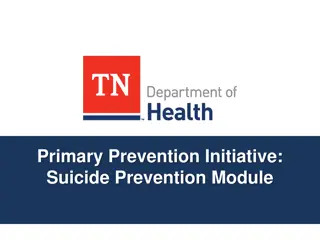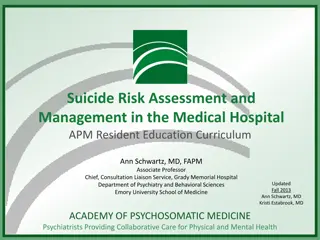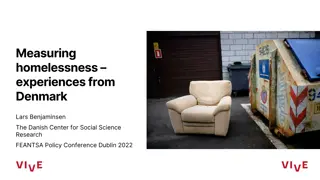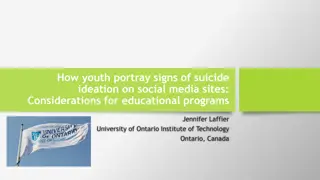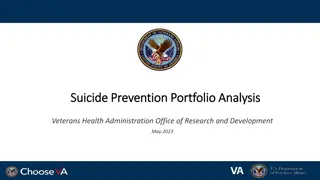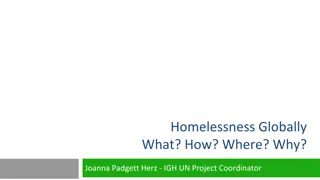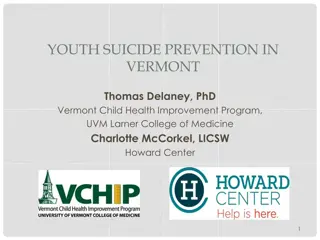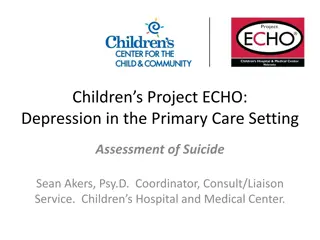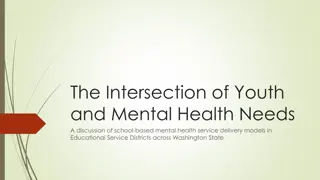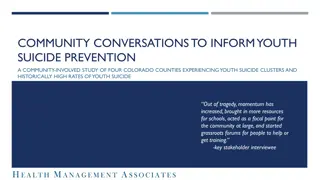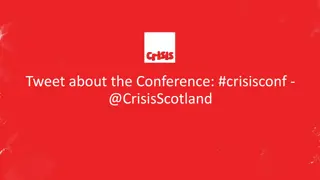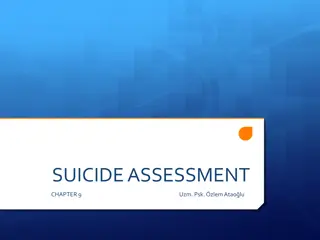Webinar on Suicide Prevention and Wellbeing Management in Homelessness
Explore the critical connection between suicide and homelessness, with a focus on supporting clients, identifying risks, addressing misconceptions, and normalizing emotional responses. Speakers share insights on mental health, resilience, and resources to end homelessness together.
Download Presentation

Please find below an Image/Link to download the presentation.
The content on the website is provided AS IS for your information and personal use only. It may not be sold, licensed, or shared on other websites without obtaining consent from the author.If you encounter any issues during the download, it is possible that the publisher has removed the file from their server.
You are allowed to download the files provided on this website for personal or commercial use, subject to the condition that they are used lawfully. All files are the property of their respective owners.
The content on the website is provided AS IS for your information and personal use only. It may not be sold, licensed, or shared on other websites without obtaining consent from the author.
E N D
Presentation Transcript
Webinar: Suicide prevention & managing wellbeing Chair: Ed Addison, Service Manager London Navigator Team, St Mungo s Speaker: Dr Colm Gallagher, Clinical Lead/Clinical Psychologist, Manchester Mental Health Homeless Team Speaker: Niamh Brophy, Homeless Palliative Care Coordinator, St Ann s Hospice, Manchester Let s end homelessness together www.homeless.org.uk
What well cover today Background on suicide and homelessness Explore how to support the mental health of clients and identify when they may be deteriorating Look at how we can build resilience amongst staff Resources that frontline staff and managers may find useful Q&A
Being mindful and taking care This training may be challenging due to topic area If you feel you experience distress during the session please speak with one of your team members or manager
Suicide and homelessness 61% of study sample (330 people) reported suicidal ideation and 34% had attempted suicide. Childhood homelessness of at least 1 week without family members and periods of homelessness longer than 6 months were found to be associated with suicidal ideation. (Eynan et al., (2002) ONS (2019), Suicides among homeless people increased by 30.2% in one year, from 86 estimated deaths in 2018 (11.8% of the total number), to 112 estimated deaths in 2019 (14.4% of the total number). Deaths of homeless people in England and Wales - Office for National Statistics (ons.gov.uk) Eynan, R., Langley, J., Tolomiczenko, G., Rhodes, A.E., Links, P., Wasylenki, D. and Goering, P. (2002), The Association between Homelessness and Suicidal Ideation and Behaviors: Results of a Cross sectional Survey. Suicide and Life Threatening Behavior, 32: 418-427. https://doi.org/10.1521/suli.32.4.418.22341
Common misconceptions about suicide Most suicides occur without warning People who talk about it do this for attention Talking about suicide could give someone the idea
Deteriorating mental health/suicide risk Warning signs Imminent Risk Tipping point Risk factors No hope for the future Self Self- -loathing, self loathing, self- - hatred hatred Feelings of worthlessness, guilt, shame, and self-hatred. Feeling like a burden. Talking Talking about suicide Searching for access means No sense of purpose perceived reason for living Increase in substance Increase in substance use use Feeling trapped/ trapped/no way out Withdrawing Withdrawing from support network/those around them Relationship ending Deteriorating health Recent bereavements Suicide of someone known to them Suicides reported in the media/celebrity Experiencing current abuse Has suicidal intent Has a plan of how to carry it out Has access to the means to do this Is impulsive or aggressive Gender Gender (male) History History of attempts Family history of suicide Mental health Mental health difficulties Physical illness illness Childhood trauma Substance use Substance use Isolation Isolation/lack of support network Bereavement Bereavement accessto trauma purposeor Health and wellbeing Suicide warning signs (nwbh.nhs.uk)
Remembering protective factors Connection Partner/child/parent Friends or peers Services One person you feel you can relate to Problem solving and coping skills to get through a crisis Religion/spirituality Having sense of belonging/purpose in life
Identifying and responding to suicide risk Why might it be hard to talk to someone about your concerns? Reconnecting person with everyday world Ask simple factual questions Try not to talk about yourself Allow for periods of silence, it maybe that person is gathering their thoughts Don t judge that persons thoughts, feelings or emotions Re-state the message. Clarify the message. Repeat the message. If you feel you have said the wrong thing, don t panic, trust instincts Move them away from physical danger What might help?
Identifying and responding to suicide risk Do they feel unsafe? What is the intensity of their feeling (for how long/how intense)? Do they have plans? Do they have intent? Additional considerations Substance/?Withdrawal History of violence Paranoia Medication non compliance Physical illness/pain Difficulties in communication Feeling discriminated/stresses, low self-esteem Coproduce safety plan Utilise protective factors!
What to include in safety plan What helps the individual to manage suicidal thoughts or feelings in their experience? What coping strategies have been useful in the past/what support is needed? What is the best course of action for them in the event of a crisis? What will they want to do when they experience suicidal thoughts and feelings Who do they prefer to speak to when they have suicidal thoughts or feelings? This may include a friend or relative, a staff member in your project, another professional or a telephone helpline. Which other agencies can they contact or who are they happy to be contacted by staff on their behalf (such as support or advice lines, Mental Health Teams or Emergency Services)? Depending on circumstances, service users may be able to identify a safe place to go.
Does the plan keep the person safe for now? Is there a need for immediate professional help? Is there a risk of acting on suicidal thoughts right away? If there is immediate risk: Emergency services A&E GP
Sharing a personal account Sharing a personal account
Part 2. Staff Resilience and Community/Team wellbeing Poll: There is adequate time and flexibility in my role to come together with other team/organisation members to reflect on our work (agree disagree) likert scale answer
Dominant Cultural Paradigm Is very limited in providing solutions We are forced to determine right and wrong, good and bad, punishments and rewards and evaluate, judge, criticize, blame, take responsibility, shame and the worst of all, compromise
Team decision Model This model argues that teams operate along two continua me-team and me-client This creates four quadrants me-me me-client team-client team-me Martin J. Dorahy & Geraldine Hamilton (2009) The Narcissistic-We model: A conceptual framework for multidisciplinary team working, researching and decision-making with traumatised individuals, Counselling and Psychotherapy Research, 9:1, 57-64, DOI: 10.1080/14733140802656438
ME Neither team nor client are considered in decision making Defensive practice Protect professional identity Protect professional worth ME
Client Lack of engagement of team Devalues input of other members Conflict / splitting Psychological divisions in clients mind o Need to keep bad things separate rather than promoting integration Other members cast in negative/disruptive roles Lack of acknowledgment of professional limitation Me
Client Clients wishes/opinions motivations heard Team ideas, experiences heard Clinical judgement Opinions of individuals are lost to a wider critiqued group think All voices are acknowledged High level of transparency Team
Team Role of educating the team about skills, limitations and dilemmas Impact of clients on team discussed Feelings of deskilled, devalued, stuckness are illuminated Promotion of role of clinical supervision, team discussion and support o An outsider eye Me
Client Lack of engagement of team Devalues input of other members Conflict / splitting Psychological divisions in clients mind Need to keep bad things separate rather than promoting integration Other members cast in negative/disruptive roles Lack of acknowledgment of professional limitation Clients wishes/opinions motivations heard Team ideas, experiences heard Clinical judgement Opinions of individuals are lost to a wider critiqued group think All voices are acknowledged High level of transparency Me Team Role of educating the team about skills, limitations and dilemmas Impact of clients on team discussed Feelings of deskilled, devalued, stuckness are illuminated Promotion of role of clinical supervision, team discussion and support An outsider eye Neither team nor client are considered in decision making Defensive practice Protect professional identity Protect professional worth Me
Understanding this team decision model leads to - Greater sense of goal-directed activity and cohesion developed when using model Dynamic tension within model (groups always are) Contradictory processes of progression and regression, individuality and belonging, attachment and alienation.
Compassion Compassion is basic kindness, with a deep awareness of the suffering of oneself and of other living things, with a wish and effort to relieve Understanding our complex minds Understanding why it can feel difficult to manage difficult emotions Vicarious Trauma
Understanding our values What are the values that drew you to do this work? What ways of being in this work do you value, hold close? What values are required for your work, without which you would be unable to work? What is the history of your relationship to these values? Who taught you this? How have these ethics shown up in your life and work? What values do we hold collectively? What values are alive in our work when we re doing work that clients experience as most useful? How do we do this work in ways that are in accord to our collective values? How can the holding close of these foster sustainability and transformation across time? Adapted from Reynolds (2011)
Keeping our values at the heart of our work How can we be connected with our values in our work? How do we hold onto our collective ethics more fully? How can we act in solidarity to keep the spirit of justice alive in our collective work and lives? How can we change the unjust structures that oppress people - - COVID? Adapted from Reynolds (2011)
Debriefing with Collective Care Vikki Reynolds Think about collective care and not just self care Debriefing What not to do? (venting it retraumatises ourselves, if we don t shift the meaning) Repetition of negativity leads to vicarious trauma Commitment to do connection work Make sure we agree to meet - - body/emotions/spirit/intellect/social relationship Trauma/overwhelmed does not co-exist with creativity Don t have to ask what happened? Sharing accounts re-traumatising Instead ask what do you need? Issue if people may not be able to tell you .but if you give choices then it ll be easier (cigarette/walk/ anything) Don t leave until they are connected to us / / and them to them Reynolds, V. (2011) Resisting Burnout with Justice Doing, The International Journal of Narrative Therapy and Community Work, No. 4 https://vikkireynoldsdotca.files.wordpress.com/2017/12/reynolds2011resistingburnoutwithjustice-doingdulwich.pdf
What did they do right? As this creates protocols for what should happen What is it that we have to do differently? What did not go ok (either hold on or problem solve when ready) Commitment to each other as workers, and not leave each other in avoidant or enmeshed relationships Doesn t take along time / but better sooner than later
Advice for homeless workers The only advice I would give, would be to be patient and understand someone s feelings through there actions. As a previous homeless person I always used to say it s okay. But it s your job to know it s not, ask questions but no more than a few to know what s up. We want you to ask, we want you to care! . As being homeless we feel like we re a burden and feel the pressure of the word on our shoulders, just show you care, refer us to the right departments, make ya feel comfortable to return back to the hep centre. We need you just show us we re welcome.
Example Microsoft Word - Suicide prevention in homelessness services DRAFT Homeless in Europe - Autumn 2018.pdf (feantsa.org) https://shiningalightonsuicide.org.uk/learn-to-save-a-life/
Resources for clients Local Community Mental Health Teams may have Crisis lines or Single Points of Access numbers that can be shared with service users. Samaritans Call 116 123 Email jo@samaritans.org www.samaritans.org CALM (Campaign Against Living Miserably) For men who are down or finding it hard to cope. The helpline and webchat are free and confidential and are open every day from 5pm to midnight. Call 0800 58 58 58 / 0808 802 5858 (London) www.thecalmzone.net Papyrus For young people who are having thoughts of suicide and anyone who is worried that a young person may be at risk of suicide. 9am-10pm week; 2pm-10pm weekend Call 0800 068 41 41 Text 07786209697 Email pat@papyrus-uk.org www.papyrus-uk.org Sane Specialist emotional support and information to anyone affected by mental illness, including family, friends and carers. 4.30pm to 10.30pm, 7 days per week Call 0300 304 7000 www.sane.org.uk
Resources for staff Homeless Link Suicide Prevention Training Aneemo.com offers online training for homeless sector staff Connecting with People offers training in suicide and self-harm mitigation that has been informed by evidence-based principles. It aims to increase empathy, reduce stigma and enhance participants ability to compassionately respond to someone who has suicidal thoughts or following self-harm: www.connectingwithpeople.org Samaritans offer training for anyone whose role may bring them into direct contact with people who have suicidal feelings. www.samaritans.org/for-business/workplace-training Storm are a not-for-profit social business committed to enhancing knowledge and skills in suicide prevention and self-harm mitigation: www.stormskillstraining.co.uk/dev/index.php PAPYRUS specialise in delivering community-based education based on their experience of working with young people and caregivers: www.papyrus-uk.org/training Royal College of GPs (RCGP) offer free suicide prevention e-learning: www.rcgp.org.uk/learning/online-learning/ole/suicide-prevention.aspx Applied Suicide Intervention Skills Training (ASIST) is an in-depth, two-day course to build skills to provide suicide first aid interventions. A number of organisations are accredited to deliver this training in the UK, and can be found via an internet search.
Thank you for listening Thank you for listening Dr Colm Gallagher, Clinical Lead/Clinical Psychologist, Mental Health Homeless Team Niamh Brophy , Homeless Palliative Care Coordinator, St Ann s Hospice, Manchester
